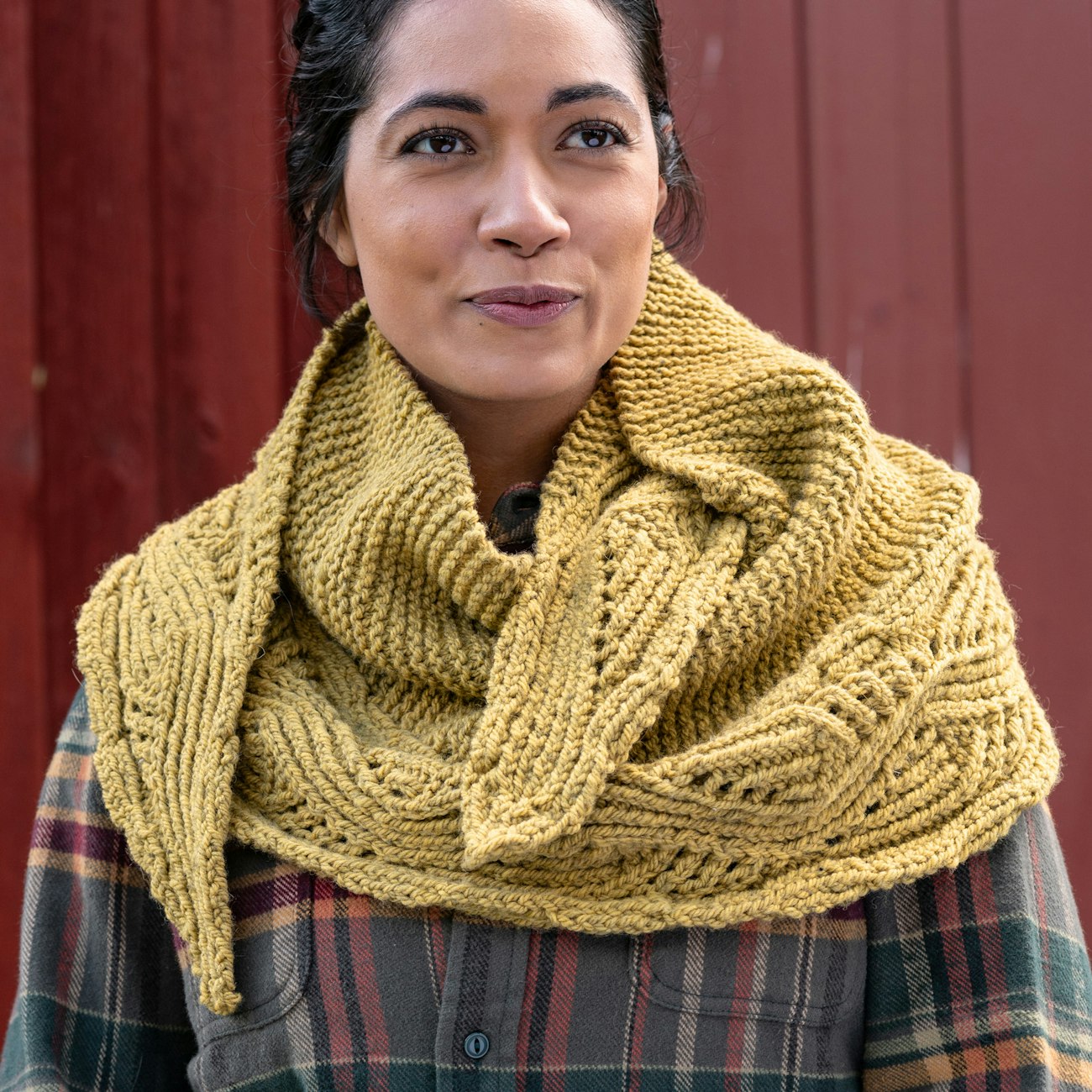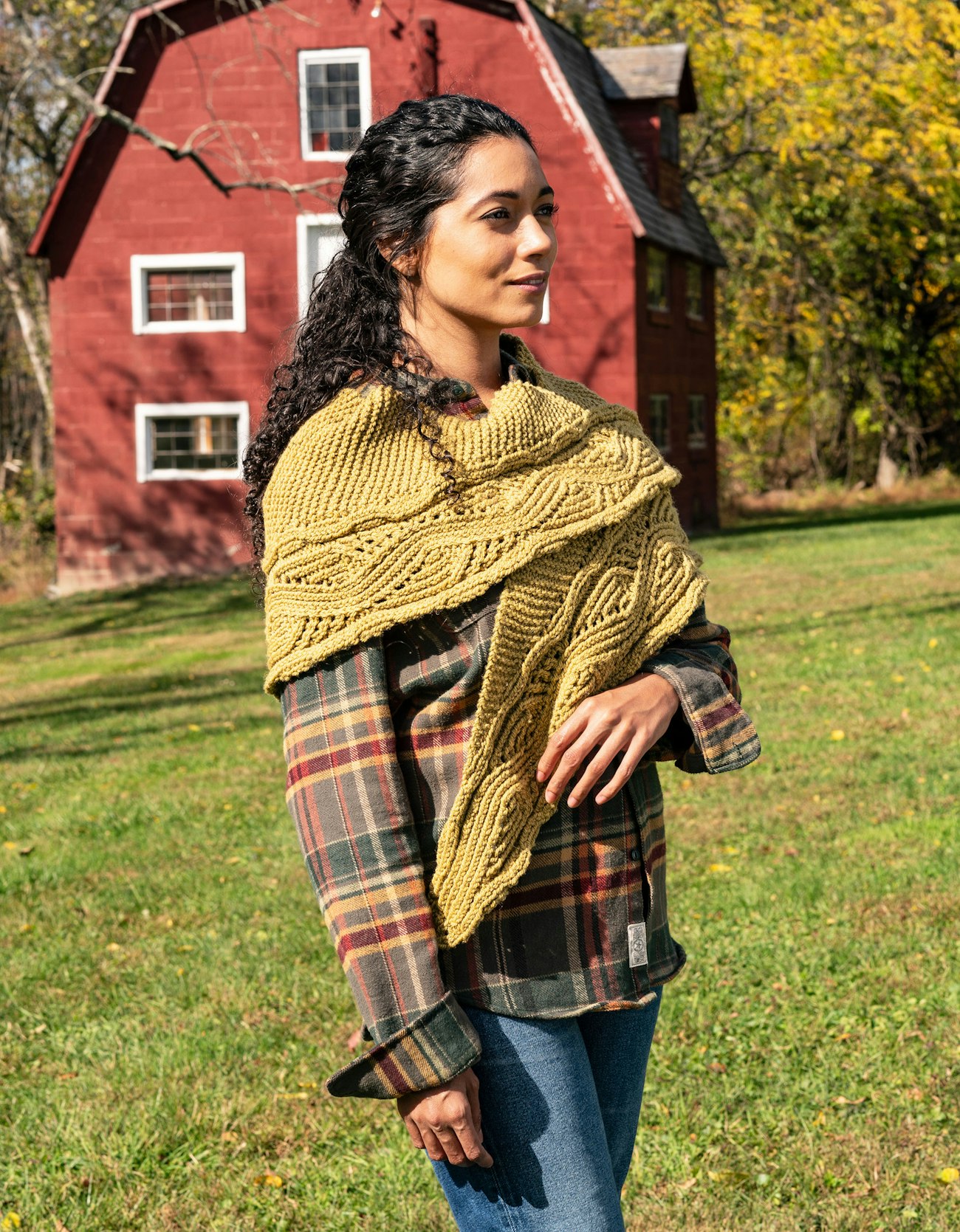I’ve always loved a garter-stitch shawl worked sideways with a lace border. Settling into a rhythm with the plain sections, I can focus on the border design. For those of us who relish a game of yarn chicken, it’s easy to tell when the time has come to begin working the decrease sections.
Angela Hahn’s Colubrida Wrap takes the format and adds a few twists—literally: cables, twisted stitches, and paired yarnover-decrease combinations make the border pattern move back and forth in a dynamic, ribbonlike pattern. Though you might never know it when just admiring the shawl from across the room, Angela took her inspiration from the sinuous shape of a snake. And you will definitely feel clever with this pattern relaxing around your shoulders.
A Lively Pattern
Angela took on a challenge by trying to capture the snake in stitches. The pattern begins at the nose, with yarnovers forming the eyes and increases broadening the border to its full width. Because the pattern is making a picture instead of a traditional pattern, the first part of the chart can present a challenge to those of us who are accustomed to reading our knitting. If you trust Angela’s chart, a gentle serpent’s head emerges. Fear not, he’s friendly.
 You can just make out the nose and eyes of the snake on the end of the shawl at right.
You can just make out the nose and eyes of the snake on the end of the shawl at right.
The twisted stitch panel of the border pattern moves left and right in a gentle sweep. At first glance, this doesn’t look like a lace shawl, but the yarnover increases that shape the edging add airiness.
Even experienced knitters might see unfamiliar stitches in this chart, but they’re easy to execute: the twisted-stitch columns call for purling through the back loop on all wrong-side rows. It’s an unfamiliar move but not a hard one.
In another twist, the cable crossings every 8 rows include the very first and last stitches of the border—which looks strange and curly when you knit it but turns into a pleasantly wiggly finish. (Be careful not to let the stitch marker that separates the garter-stitch section from the border slip out of place when working the cables.)
 The twisted stitches and cable crosses give the pattern a sense of movement.
The twisted stitches and cable crosses give the pattern a sense of movement.
Yarn Choices
The original version of this shawl used a now-discontinued yarn composed mainly of alpaca, which gave it substantial drape. Instead of that sleek and slithery yarn, we chose a 100% wool yarn for this updated version. (If I called it muscular and a little toothy, would that give you the shivers? Here, have a warm shawl to warm you right up.)
The Corriedale wool for which the Stone Wool is named generally feels more robust than the super-soft Merino that many of us have come to expect in a shawl yarn. (Learn about Gale Zucker’s visit to a Corriedale farm—and see some sweet faces and luscious fleeces—in “Field Trip: How to Make a Farm Yarn? Go Straight to the Pasture.”) The longer staple of Corriedale wool generally means less pilling, as does the 3-ply structure of the yarn. The yarn combines white and naturally colored fleece for a heathered look; when overdyed, it takes on a rustic depth. With wool’s natural elasticity, you can wear a shawl knitted from this yarn for years without it looking tired or ragged.
Most shawl patterns call for a lighter-weight yarn than Aran weight, and as a result the shawl feels more substantial and cozy than light and airy. This makes the knitting go faster, and it makes this an excellent cool-weather piece. The chunkier yarn also gives the graphic border pattern and garter stitch panel an extra visual pop.
If you’re looking for a thoughtful shawl that rewards a little attention with a striking result, cast on Angela Hahn’s Colubrida Shawl.

